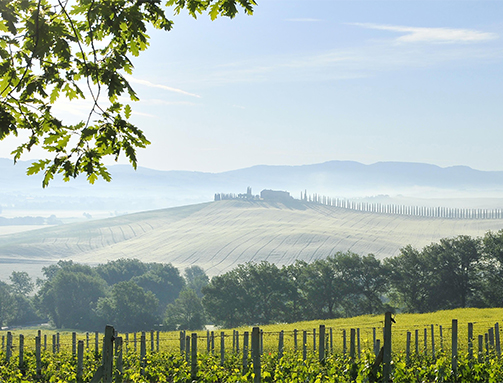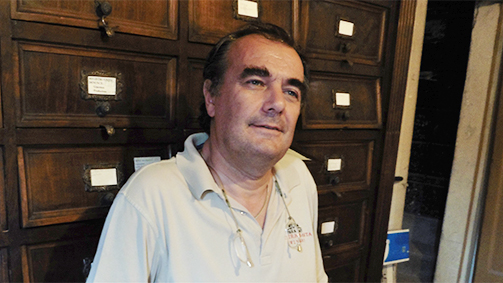Wine Tourism and Hospitality: An analysis by Carlo Pietrasanta, President of Movimento Turismo Vino
The Class of 1962, Carlo Giovanni Pietrasanta is among the founding partners of the Wine Tourism Movement Italy (Movimento Turismo del Vino Italia), an association dedicated to the development of wine tourism and hospitality. He has been president of the movement since 2015.
The association’s goal, as the president explains, is to promote the culture of wine through visits to the wineries. In this sense, the discipline hospitality marketing is just being introduced to the world of wine, a modern way of reviving and valuing a practise that used to be a natural part of operating a winery.
Intervista a Carlo Pietrasanta, Presidente Movimento turismo Vino: Un’analisi su Enoturismo e Marketing dell’Accoglienza - Prima Parte from SGA Wine design on Vimeo.
How well do you think the wineries, businesses and people who offer tourist services are actually prepared for it?
There are those who are well prepared, but it’s patchy. We have some excellent examples, there is a core of operators that have learned through experience: they started their own wine tourism 25 years ago and have learned how to host visitors and promote their wineries. Today we need to create new incentives because the world has changed in the last 25 years. Today, with online communication, you need to be ready to greet the new wave of wine tourists who come from all over the world, treating the Japanese tourist in one way and the American tourist in a completely different way. The Movement’s goal is to educate and prepare its wineries for these influxes of tourists.
The importance of the culture of marketing applied to hospitality is evident, but how many wineries are aware of this?
Very few: often we producers rightly dedicate a lot of our time and effort to the vineyard and the cellar, but due to our lack of education in the subject, we forget about the marketing and communication side of things. This is especially true at small wineries, with few members of staff where the producer has to do a bit of everything.
And how much do the consumers know about it?
In Italy there’s a huge difference between the passionate Wine Lovers and the general public, who visit the winery to learn about winemaking. The general public is uninformed but can have a very satisfying experience that can turn the product, if it goes down well, into one of their “everyday wines”. Also, a more evolved public is arriving from abroad, in search of something special. I’m referring above all to countries that are already in their second and third generations of wine drinkers: the United States, Japan, Anglo-Saxon countries. In these countries, consumers have evolved and now seek out grape varieties and wines that are less well known. And then there are the emerging markets, like Russia, the Chinese market, the Far East, with a public who are less informed but nevertheless curious and interested.
What role does this component have in the marketing mix of companies?
In my opinion it should have an important role since without marketing and without communication you can’t get very far today, especially if you’re based in an area that’s not well known. By applying the right marketing and communication tools, even in a region that is not one of Italy’s most famous, a producer can achieve excellent results.
Is it possible to categorise clients in order to differentiate the offer?
It’s essential: especially for large-scale events like “Cantine Aperte”. These have to be different environments to accommodate both the wine lover, who should be pampered, and the general public, who just want to try a couple of wines and take away a couple of bottles as souvenirs.
What can the WTM do to spread this kind of sensibility? Today the WTM promotes this service, but can it also spread the culture of marketing to individual wineries?
It must do because it is key to the continuing success of wine tourism: it must help its associated wineries to be prepared on this front. The message is: not just making excellent wines but also knowing how to communicate and present them.

Ph: Francesco Radino
What are, in fact, the main functions of the WTM?
The main function of the Wine Tourism Movement is to unite wineries that believe in wine tourism hospitality, taking advantage of the five national events that have been created and by now consolidated, such as “Cantine Aperte” and “Calici di Stelle”, that have been running for more than 20 years and are the supporting pillars of communal activity (for Cantine Aperte, all the wineries open their doors on the same day). The Movement is committed to assisting the wineries to be better prepared in other areas: a winery is born to cultivate the vineyards and produce wine, but today they also need all the rest.
How then, is the Wine Tourism Movement structured?
The Wine Tourism Movement, on a national level, is a second-level organisation, consisting of 20 regional associations: the wineries are partners on a regional level. There are regions that have secretaries who organise the constant activities that involve the member wineries throughout the year. On a national level, we are moving forward with strategic agreements in a variety of areas, from finance to car hire, to offer more services to visitors.
What are the main objectives of its mandate?
To help the wineries of the Wine Tourism Movement sell more visits, more bottles of wine.
The aim of the mandate is to transform the Movement from a voluntary association into an association that can make it on its own with constant organisation, even if the presidents change. Furthermore, I’m trying to start working with tour operators and other subjects to bring in some limited royalties to the national association, so that we can weigh less and less on the wineries. This does not mean devaluing the association, but it means that the wineries will get much more for the same amount they are paying now.
What are the advantages for the wineries, what incentivises them to sign up to the Movement?
The advantage is that they join a network that moves a lot of people: during the national events, like Cantine Aperte, at least 60-70% of those participating don’t just visit one winery, they move around and see several. Being part of this circuit means finding new customers and meeting new people. Where consumers used to find a winery they liked and bought all their wine from there, today’s consumer buys one wine from me, another from someone else, and they build their personalised collection.

As a movement, have you formed any particular relationships with tour operators? How common are relationships with tour operators? Is the movement known to just a few specialised tour operators is it common in wine tourism?
There are tour operators (especially American and English), that are very active in wine tourism and there are wineries, both associates of the movement and not, that have close relationships with these tour operators. We as a movement are a little behind in this. We’re trying to catch up and soon we’ll finalise agreements that have already been set in motion for platforms linked to a virtual tour operator that will exclusively sell the destination Italy.
Why and when is it convenient for a winery to use Faberest (platform for booking visits to wineries)?
Faberest is a new platform created by some guys I met four years ago just after they’d graduated. It develops an idea that we put out there four years ago: to sell recreational-educational activities at wineries, and more (you can go and see how cheese is made, and so on). It is one of the many platforms that can help us to intercept wine lovers and curious customers that want to come to see our wineries. Thanks to the benefits afforded the movement, wineries associated with the WTM can access this platform without initial costs and with lower percentages of the revenue than wineries not in the WTM.
What is Faberest like compared to a dedicated section of a winery’s website, or with other sites that sell tours and packages?
There are companies that have websites where customers can book and pay for a visit, there are other sites that offer other opportunities… a few days ago the “Tripadvisor of wine” was presented. I think that every portal of this kind has its own characteristics; in my opinion, even if we’re talking about digital tools, the people behind it make the difference.
How much do the wineries that offer this kind of service interact with their customers on their preferred platforms?
Not very much as yet. One of the aims of the Wine Tourism Movement is to increase this interaction; we’re creating a synergy with some platforms that will allow wine lovers to discover new opportunities, new visits and new producers. Furthermore, as in all fields, we aim to profile the consumer in order to involve them with targeted offers.
How much do wineries respond to guest reviews left for example on Tripadvisor or other platforms (like Booking.com, Trivago, Expedia…)?
We have to respond because it’s our reputation. Not all wineries manage to stay on top of it and therefore it’s important to join forces and, as we are currently proposing, assign someone to take care of this aspect for a larger number of subjects.
Tag Interview, Wine Tourism


